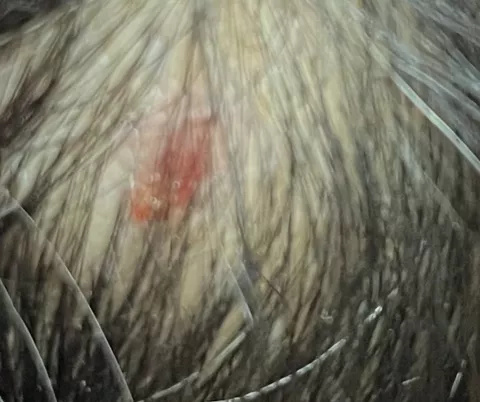If you have concerns about your skin
Adult hearing implant skin care
If you have any concerns, you can email us a photo of your skin around the hearing implant. We can then give you advice about what to do.
We may recommend that you use a barrier cream, such as Medihoney®, on your skin. Whenever you start using a new medical product, it is best to check the area within the first hour. You can then make sure that there is no allergic reaction and stop using the cream if your skin looks worse afterwards.
We have created films that show you how to
- change your dressing around your bone conduction hearing implant
- look after the skin around your bone conduction hearing implant
Red tender skin
You may have red tender skin under or around the processor or hearing implant scar, as shown in the following photo. It may be harder to notice the redness on brown and black skin.

Here are tips about what to do if you have these skin symptoms:
Do
- put a barrier cream, such as Medihoney, gently on your skin before and after wearing the headpiece
- reduce the magnet strength, if possible
- use a spacer, foam disc or moleskin patch to protect the skin from more pressure, if you cannot reduce the magnet strength
- email our hearing implant centre a photo of the area if it has not settled or has got worse within 7 days
Don't
- do not wear the processor when you are asleep
Broken skin
You may have broken skin under or around the processor or hearing implant scar, as shown in the following photo:

Here are tips about what to do if you have these skin symptoms:
Do
- email our hearing implant centre a photo of the area
- book an urgent appointment in our hearing implant centre
- keep the area dry when you have a shower or bath
- use a barrier cream, such as Medihoney, to protect the area
Don't
- do not wear the processor until our hearing implant centre has given you advice
- do not allow the arm of your glasses or anything else to put pressure on the broken area of skin
Swelling
You may have swelling under or around the processor or hearing implant scar, as shown in the following photo:

Here are tips about what to do if you have these skin symptoms:
Do
- email our hearing implant centre a photo of the area
- book an urgent appointment in our hearing implant centre
- keep the area dry when you have a shower or bath
- use a barrier cream, such as Medihoney, to protect the area
Don't
- do not wear the processor until our hearing implant centre has given you advice
- do not allow the arm of your glasses or anything else to put pressure on the swollen area of skin
Contact us urgently or go to A&E outside working hours if:
- your skin symptoms get worse
- you feel unwell
- you get a high temperature (fever)
You are likely to need treatment with antibiotics.
Crusty skin
You may get crusty skin under or around the processor or hearing implant scar, as shown in the following photo:

Here are tips about what to do if you have these skin symptoms:
Do
- email our hearing implant centre a photo of the area
- book an urgent appointment in our hearing implant centre
- keep the area dry when you have a shower or bath
- use a barrier cream, such as Medihoney, to protect the area
Don't
- do not wear the processor until our hearing implant centre has given you advice
- do not allow the arm of your glasses or anything else to put pressure on the crusty area of skin
Contact us urgently or go to A&E outside working hours if:
- your skin symptoms get worse
- you feel unwell
- you get a high temperature (fever)
You are likely to need treatment with antibiotics.

